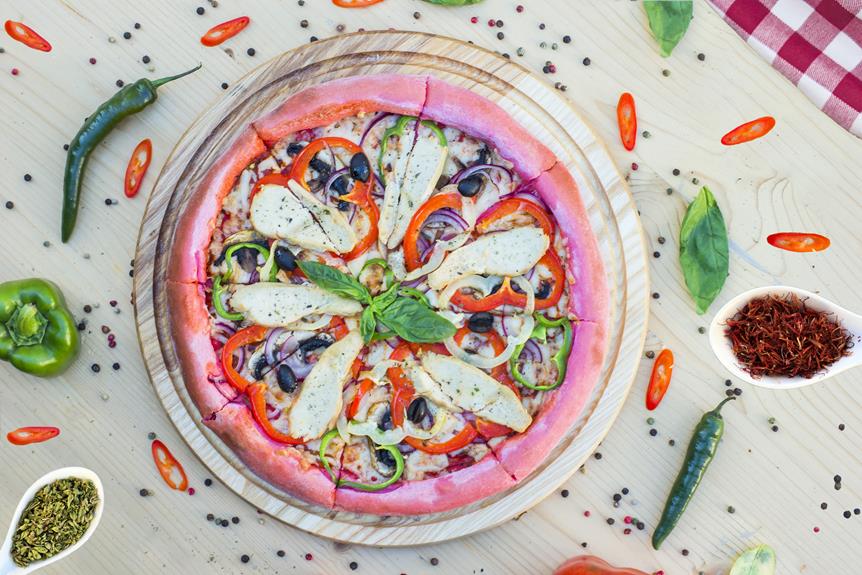Ever wondered about the vibrant palette of your favorite cheesy delight?
Brace yourself for a delectable journey into the world of pizza colors. From the rich, golden hues of a perfectly baked crust to the tantalizing shades of tomatoes and toppings, you'll explore the science and artistry behind the diverse colors that adorn your pizza.
Discover how ingredients, cooking methods, and even regional influences contribute to this mouthwatering symphony of colors.
Get ready to feast your eyes on the mesmerizing palette of pizza perfection.
The Science of Pizza Color
To understand the science of pizza color, you need to explore how different ingredients and cooking methods affect its hue. One crucial aspect is analyzing pizza crust browning. The crust's color can vary depending on factors like dough composition, baking temperature, and time. A longer baking time or higher temperature can result in a darker, more golden crust. On the other hand, a shorter baking time or lower temperature may yield a lighter, more pale crust.
Another factor to consider is the effect of cheese melting on pizza color. As the cheese melts, it can take on a beautifully golden hue, adding to the overall color of the pizza. The type of cheese used, such as mozzarella or cheddar, can also influence the final color.
The Role of Ingredients in Pizza Color
As you frequently experiment with various ingredients in your pizza, you'll notice how they play a significant role in determining its color.
The dough, for instance, is a key factor. A thin and light-colored dough will result in a pizza with a paler appearance, while a thicker and darker dough will give it a richer, golden hue.
Toppings also have a significant impact on pizza color. For example, vibrant red tomato sauce will contribute to a reddish tone, while green vegetables like spinach or basil can add a touch of freshness. Additionally, meats such as pepperoni or sausage can bring in darker shades.
Lastly, melted cheese creates a beautiful golden-brown color that adds a mouthwatering appeal to your pizza.
How Cooking Methods Influence Pizza Color
When you cook your pizza using different methods, you'll notice how they impact its color. Cooking techniques play a crucial role in determining the final appearance of your pizza.
The color of a pizza can vary based on the cooking method employed, whether it's baking in an oven, grilling on a barbecue, or frying in a pan. Each technique brings its own unique characteristics to the pizza's color.
Baking in an oven typically results in a golden brown crust and lightly browned toppings. Grilling on a barbecue can give your pizza a slightly charred and smoky appearance. Frying in a pan may result in a darker and crispier crust.
Exploring Regional Variations in Pizza Color
Explore the diverse range of pizza colors found across different regions. Regional preferences in pizza color reflect cultural significance and local traditions. Here are some interesting variations:
- Neapolitan Pizza: In its birthplace of Naples, Italy, Neapolitan pizza is known for its vibrant, golden-brown crust. The dough is cooked at high temperatures in a wood-fired oven, resulting in a slightly charred exterior and a soft, chewy interior.
- New York Style Pizza: In the bustling streets of New York City, the iconic New York style pizza boasts a light to medium golden-brown color. The thin crust is typically hand-tossed and baked in a deck oven, resulting in a crispy texture.
- Chicago Deep Dish Pizza: Deep dish pizza is a Chicago specialty, known for its deep, dark golden-brown crust. The thick, buttery crust is baked in a deep pan, creating a crispy and flaky texture.
- California Pizza: On the West Coast, California-style pizza embraces creativity and innovation. From vibrant green pesto bases to colorful toppings like sun-dried tomatoes and fresh avocado, the colors of California pizza are as diverse as the state itself.
These regional preferences in pizza color not only add visual appeal but also provide a glimpse into the unique culinary traditions and cultural significance of each region.
The Psychological Impact of Pizza Color
The color of pizza can have a significant psychological impact on your perception and enjoyment of the food. Color symbolism in food psychology plays a crucial role in how we perceive and experience different food items, including pizza.
When it comes to pizza, the impact of color on food perception is undeniable. The color of the crust, the toppings, and even the cheese can influence our expectations and ultimately our satisfaction with the meal.
For example, a golden-brown crust can evoke feelings of warmth and comfort, while vibrant red tomato sauce can signify freshness and flavor.
The color of pizza can set the stage for our dining experience, shaping our anticipation and enhancing our overall enjoyment of this beloved dish.
Conclusion
So, the question remains: what color is pizza? Well, the answer isn't as simple as black and white.
Pizza color can vary depending on a myriad of factors, such as the ingredients used, cooking methods employed, and even regional variations.
From vibrant red tomato sauce to golden-brown crusts, pizza delights our senses with a palette of colors.
As they say, 'The proof is in the pudding' or, in this case, the pizza.
So go ahead, indulge in a slice of pizza and marvel at its deliciously diverse colors.

